
loading
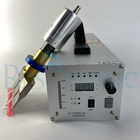

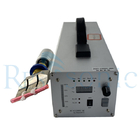

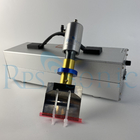

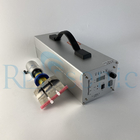

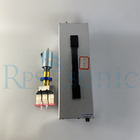

| Place of Origin | China |
|---|---|
| Brand Name | Rps-sonic |
| Certification | CE |
| Model Number | RPS-C40 |
| Minimum Order Quantity | 1pcs |
| Price | negotiable |
| Packaging Details | CARTON |
| Delivery Time | 1DAYS |
| Payment Terms | T/T |
| Supply Ability | 200PCS/MONTH |
| Frequency | 40Khz | Power | 600w |
|---|---|---|---|
| Blade Size | 82.5mm | Blade Material | Titanium |
| Voltage | 220/110V | Weight | 8kg |
| Application | Food,rubber | Generator | Digital |
| High Light | Digital Generator Ultrasonic Cutting Equipment,Rubber Ultrasonic Cutting Device,500w Ultrasonic Cutting Device | ||
40khz 500w Rubber Ultrasonic Cutting Device With Digital Generator
40khz 500w Coutinous working Ultrasonic Rubber cutting device with digital generator
What's the principle of ultrasonic cutting?
The principle of an ultrasonic cutter is completely different from conventional one. It uses the energy of ultrasonic to melt the material to be cut. Therefore, the ultrasonic cutting does not require a sharp cutting edge, nor does it require a large pressure, and does not cause any chipping or breakage. At the same time, since the cutting blade is subjected to ultrasonic vibration, the frictional resistance is particularly small, and the material to be cut is not easily adhered to the blade. This is particularly effective for cutting viscous and elastic materials, frozen materials such as food, rubber, etc., or objects that are inconvenient to apply pressure.
The basic structure of the ultrasonic cutting machine is an ultrasonic transducer, a horn, a cutting blade (tool head), and generator. The ultrasonic generator converts the commercial power into a high-frequency high-voltage alternating current and transmits it to the ultrasonic transducer. An ultrasonic transducer is actually equivalent to an energy conversion device that converts input electrical energy into mechanical energy, ie, ultrasonic waves. Its manifestation is that the transducer moves back and forth in the longitudinal direction. The frequency of the telescopic motion is equivalent to the frequency of the high frequency alternating current supplied by the driving power source. The role of the horn is to fix the entire ultrasonic vibration system and to amplify the output amplitude of the transducer. The cutting blade (tool head) further enlarges the amplitude on the one hand and focuses the ultrasonic wave. On the other hand, the ultrasonic wave is output, and the ultrasonic energy is concentratedly input to the cutting portion of the material to be cut by using a similar cutting edge of the cutting blade. Under the action of huge ultrasonic energy, this part softens and melts instantly, and the strength is greatly reduced. At this time, as long as a small cutting force is applied, the purpose of cutting the material can be achieved.
Similar to conventional cutting, the basic components required are a cutter and an anvil, and the ultrasonic cutter has two basic structures. Depending on the location of the ultrasonic application, we may wish to divide it into an ultrasonic cutter cutter and an ultrasonic cutter cutter.
The ultrasonic cutter cutter directly loads the ultrasonic energy onto the cutter, and the cutter becomes a cutter with ultrasonic waves. When cutting the material, the material is mainly softened and melted by the ultrasonic energy, and the cutting edge of the cutter only serves as the slit positioning, the ultrasonic energy output, and the separation material. This cutting method is suitable for cutting thick, thick, long, etc. materials that are inconvenient to set the cutting board. Such as raw rubber output from the rubber mixer, pipe cutting, frozen meat, candy, chocolate cutting, printed circuit boards, or hand-held cutting machines.
The basic structure of the ultrasonic cutting board cutter is similar to that of the ultrasonic cutter cutter, except that the ultrasonic output portion is not a cutter but a standard ultrasonic flat mold. Here, the mold is equivalent to a cutting board. However, this is a cutting board that is used for ultrasonic vibration. The cutting knife can still be used in the traditional shape, but the sharpness of the cutting edge is reduced, and the life of the cutting knife is greatly extended.
1. High cutting precision and constant material shape.
2, easy to apply to automated production
3, the cutting surface has good finish and good bonding performance.
4, fast, high efficiency, no pollution.
5. The cutting part adopts the hand-held design. The whole machine is compact, beautiful in appearance and easy to operate. It can replace different size and different material cutting knives to achieve the ideal cutting equipment;
6. Ultrasonic cutting machine adopts hand-held cutting design, which can replace different specifications of cutting knife mold, which is easy to use;
7. The function module with automatic and rapid resonance of detuning can last up to 18 hours in a continuous working time without additional cold going conditions.
8. The ultrasonic power supply independently researched and developed by the company can provide 50% of the performance of the products and prolong the service life of the transducer by more than one time;
9. Ultrasonic vibration reduces the frictional resistance between the blade and the food, which makes the blade cut smoothly, reduces food fragments during the cutting process, and improves production efficiency;
10. Using the vibration handle, the operation is simple and quiet and silent when cutting, no vibration, the cutting is light and the effect is perfect;
11, with high frequency vibration of 40KHZ or 20KHZ, this low friction makes the cutting knife cut food smoothly, making the food cutting surface clean, beautiful and not deformed;
12. It can be used by hand in a single machine, or it can be mounted on a machine to control the cutting head with a computer to form a fully automatic cutting device for the cutting of batch materials in the assembly line.
Ultrasonic Components
Typical ultrasonic food cutting components include four major elements: a power supply, a converter, a booster and a cutting horn, as explained below.
1. Power supply
The ultrasonic power supply, also referred to as a generator, is an electronic device that takes standard 50/60Hz AC line voltage and converts it to high frequency electrical energy.
2. Converter
The ultrasonic converter is a sealed electro/mechanical device that receives the 20kHz electrical energy from the power supply and converts this electrical energy to high frequency mechanical vibrations using PZT(piezoelectric) ceramic discs that expand and contract within the converter housing.
3. Booster
The booster is a machined metal mechanical amplifier that will either raise or lower the amplitude of the horn's mechanical motion depending on the configuration of the masses machined at each end.
4. Cutting horn
The cutting horn, also referred to as a knife or a blade horn, is the component that comes into contact with the product and does the actual cutting. This horn is machined from titanium, has excellent acoustic properties, good surface hardness and superior fatigue value.
Our ultrasonic components and horns are designed for continuous operation under the most demanding production environments. Welcome customers to cooperate with us for a brilliant future!
Parameter
| Machine | Ultrasonic rubber/cake Cutter |
| Frequency(KHz) | 40KHz |
| Power | 500 W |
| Cutting Blade / Horn | Titanium |
| Voltage(V) | 220V |
| The width of blade | 82.5mm |
| Cutting thickness | 10~20mm(depend on materials) |
| Horn amplitude | 10-40μm |
| Equipment weight | 0.6KG |
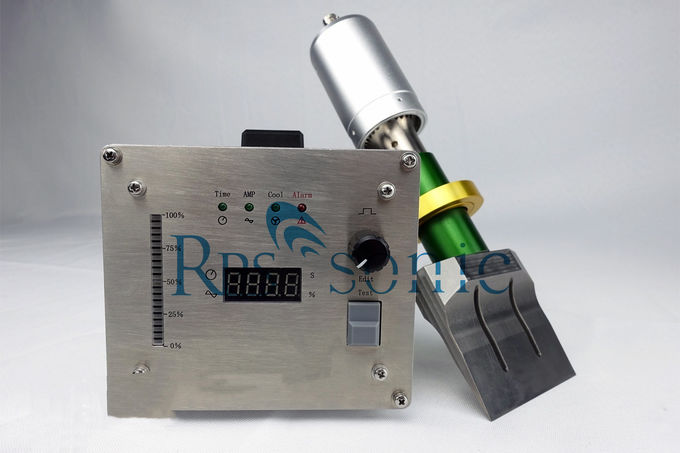
Application
Frozen cakes and pies
Frozen fish
Snack and health bars
Fresh/frozen prepared meats
Dough or baked cookies
Soft and hard cheeses
Fresh/frozen vegetables
Candy and confections
Ice cream bars
| Frequency | 40Khz | Power | 600w |
|---|---|---|---|
| Blade Size | 82.5mm | Blade Material | Titanium |
| Voltage | 220/110V | Weight | 8kg |
| Application | Food,rubber | Generator | Digital |
| High Light | Digital Generator Ultrasonic Cutting Equipment,Rubber Ultrasonic Cutting Device,500w Ultrasonic Cutting Device | ||
40khz 500w Rubber Ultrasonic Cutting Device With Digital Generator
40khz 500w Coutinous working Ultrasonic Rubber cutting device with digital generator
What's the principle of ultrasonic cutting?
The principle of an ultrasonic cutter is completely different from conventional one. It uses the energy of ultrasonic to melt the material to be cut. Therefore, the ultrasonic cutting does not require a sharp cutting edge, nor does it require a large pressure, and does not cause any chipping or breakage. At the same time, since the cutting blade is subjected to ultrasonic vibration, the frictional resistance is particularly small, and the material to be cut is not easily adhered to the blade. This is particularly effective for cutting viscous and elastic materials, frozen materials such as food, rubber, etc., or objects that are inconvenient to apply pressure.
The basic structure of the ultrasonic cutting machine is an ultrasonic transducer, a horn, a cutting blade (tool head), and generator. The ultrasonic generator converts the commercial power into a high-frequency high-voltage alternating current and transmits it to the ultrasonic transducer. An ultrasonic transducer is actually equivalent to an energy conversion device that converts input electrical energy into mechanical energy, ie, ultrasonic waves. Its manifestation is that the transducer moves back and forth in the longitudinal direction. The frequency of the telescopic motion is equivalent to the frequency of the high frequency alternating current supplied by the driving power source. The role of the horn is to fix the entire ultrasonic vibration system and to amplify the output amplitude of the transducer. The cutting blade (tool head) further enlarges the amplitude on the one hand and focuses the ultrasonic wave. On the other hand, the ultrasonic wave is output, and the ultrasonic energy is concentratedly input to the cutting portion of the material to be cut by using a similar cutting edge of the cutting blade. Under the action of huge ultrasonic energy, this part softens and melts instantly, and the strength is greatly reduced. At this time, as long as a small cutting force is applied, the purpose of cutting the material can be achieved.
Similar to conventional cutting, the basic components required are a cutter and an anvil, and the ultrasonic cutter has two basic structures. Depending on the location of the ultrasonic application, we may wish to divide it into an ultrasonic cutter cutter and an ultrasonic cutter cutter.
The ultrasonic cutter cutter directly loads the ultrasonic energy onto the cutter, and the cutter becomes a cutter with ultrasonic waves. When cutting the material, the material is mainly softened and melted by the ultrasonic energy, and the cutting edge of the cutter only serves as the slit positioning, the ultrasonic energy output, and the separation material. This cutting method is suitable for cutting thick, thick, long, etc. materials that are inconvenient to set the cutting board. Such as raw rubber output from the rubber mixer, pipe cutting, frozen meat, candy, chocolate cutting, printed circuit boards, or hand-held cutting machines.
The basic structure of the ultrasonic cutting board cutter is similar to that of the ultrasonic cutter cutter, except that the ultrasonic output portion is not a cutter but a standard ultrasonic flat mold. Here, the mold is equivalent to a cutting board. However, this is a cutting board that is used for ultrasonic vibration. The cutting knife can still be used in the traditional shape, but the sharpness of the cutting edge is reduced, and the life of the cutting knife is greatly extended.
1. High cutting precision and constant material shape.
2, easy to apply to automated production
3, the cutting surface has good finish and good bonding performance.
4, fast, high efficiency, no pollution.
5. The cutting part adopts the hand-held design. The whole machine is compact, beautiful in appearance and easy to operate. It can replace different size and different material cutting knives to achieve the ideal cutting equipment;
6. Ultrasonic cutting machine adopts hand-held cutting design, which can replace different specifications of cutting knife mold, which is easy to use;
7. The function module with automatic and rapid resonance of detuning can last up to 18 hours in a continuous working time without additional cold going conditions.
8. The ultrasonic power supply independently researched and developed by the company can provide 50% of the performance of the products and prolong the service life of the transducer by more than one time;
9. Ultrasonic vibration reduces the frictional resistance between the blade and the food, which makes the blade cut smoothly, reduces food fragments during the cutting process, and improves production efficiency;
10. Using the vibration handle, the operation is simple and quiet and silent when cutting, no vibration, the cutting is light and the effect is perfect;
11, with high frequency vibration of 40KHZ or 20KHZ, this low friction makes the cutting knife cut food smoothly, making the food cutting surface clean, beautiful and not deformed;
12. It can be used by hand in a single machine, or it can be mounted on a machine to control the cutting head with a computer to form a fully automatic cutting device for the cutting of batch materials in the assembly line.
Ultrasonic Components
Typical ultrasonic food cutting components include four major elements: a power supply, a converter, a booster and a cutting horn, as explained below.
1. Power supply
The ultrasonic power supply, also referred to as a generator, is an electronic device that takes standard 50/60Hz AC line voltage and converts it to high frequency electrical energy.
2. Converter
The ultrasonic converter is a sealed electro/mechanical device that receives the 20kHz electrical energy from the power supply and converts this electrical energy to high frequency mechanical vibrations using PZT(piezoelectric) ceramic discs that expand and contract within the converter housing.
3. Booster
The booster is a machined metal mechanical amplifier that will either raise or lower the amplitude of the horn's mechanical motion depending on the configuration of the masses machined at each end.
4. Cutting horn
The cutting horn, also referred to as a knife or a blade horn, is the component that comes into contact with the product and does the actual cutting. This horn is machined from titanium, has excellent acoustic properties, good surface hardness and superior fatigue value.
Our ultrasonic components and horns are designed for continuous operation under the most demanding production environments. Welcome customers to cooperate with us for a brilliant future!
Parameter
| Machine | Ultrasonic rubber/cake Cutter |
| Frequency(KHz) | 40KHz |
| Power | 500 W |
| Cutting Blade / Horn | Titanium |
| Voltage(V) | 220V |
| The width of blade | 82.5mm |
| Cutting thickness | 10~20mm(depend on materials) |
| Horn amplitude | 10-40μm |
| Equipment weight | 0.6KG |

Application
Frozen cakes and pies
Frozen fish
Snack and health bars
Fresh/frozen prepared meats
Dough or baked cookies
Soft and hard cheeses
Fresh/frozen vegetables
Candy and confections
Ice cream bars








Ultrasonic Welding Equipment Ultrasonic Welding Transducer Ultrasonic Welding Converter Ultrasonic Liquid Processor Ultrasonic Cutting Equipment Ultrasonic Spray Nozzles Ultrasonic Power Supply Ultrasonic Soldering Equipment Ultrasonic Welding Horn Ultrasonic Assisted Machining Ultrasonic Testing Equipment
content is empty!